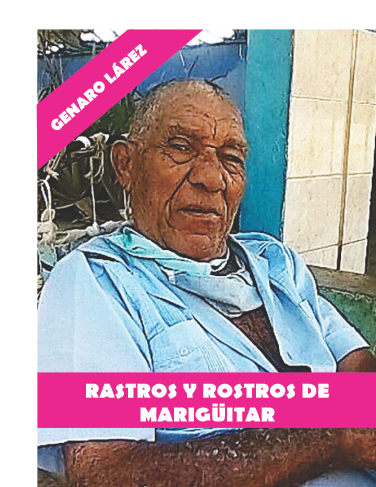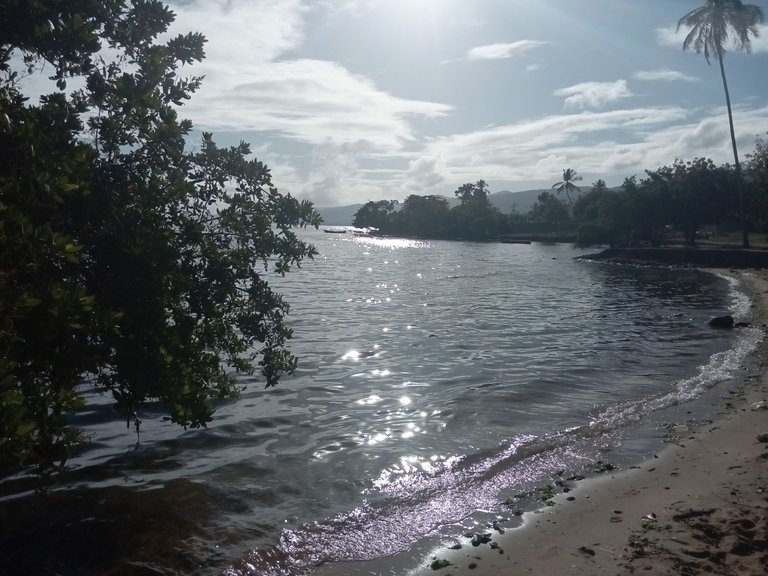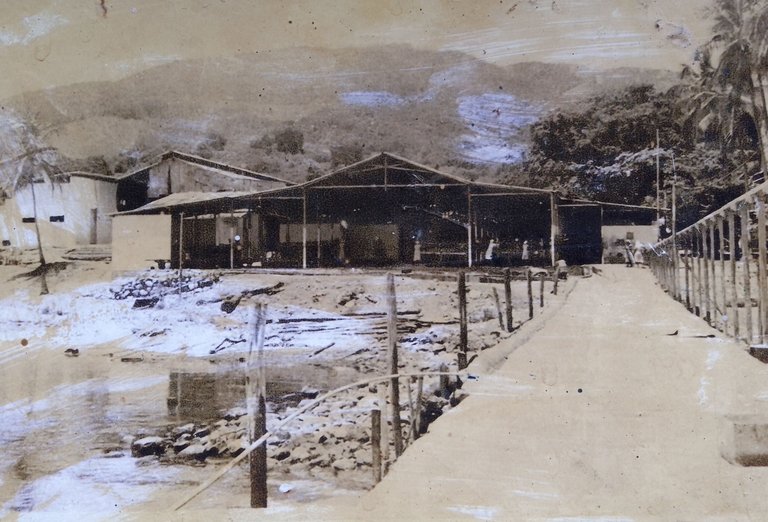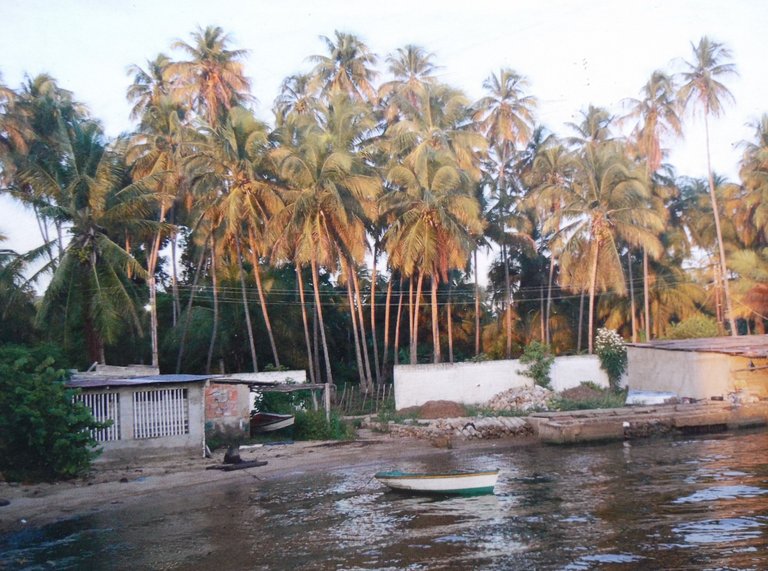@Kakigomez
Rastros y Rostros de Marigüitar
José Genaro Larez Cova
Traces and Faces of Marigüitar
José Genaro Larez Cova

The Gulf of Cariaco has always been conceived as a haven of peace, its waters have accumulated as a silent witness, stories of men and women who harvested crops and built towns. Among them, the one who arrived praying with his name on March 19, 1935, JOSÉ GENARO LÁREZ. His parents: Eloy Lárez and Luisa Josefa Cova, the former a farmer and fisherman, while his mother was the daughter of Luisa Coa, a robust black woman who in her last years sacrificed pigs on "El Roble" Street.
La familia Lárez Cova habían fijado residencia en el naciente sector "El Mamey", eran tiempos de un golfo que le ofrecía al pueblo grandes cardúmenes de peces: Pargo, Cuna, Meros, Catacos. Una época donde el pescado (Jurel) no se ofrecía a la venta por kilos, sino por piezas: 1/4, 1/2 o un Jurel completo.
The Lárez Cova family had taken up residence in the nascent "El Mamey" sector; those were times of a gulf that offered the town large schools of fish: Snapper, Cuna, Groupers, Catacos. A time when fish (mackerel) was not offered for sale by kilos, but by pieces: 1/4, 1/2 or a complete horse mackerel.

Genaro, as he was later called until today, became a fisherman and merchant very early. At the age of 17, he acquired a small boat for the modest sum of 200 bolivars that could be rowed to the points where fishing was abundant. This is how he began looking for food for the family. He alternated these days buying mangoes from the Isavas, from "chaito" Rodríguez and from every landowner there was and then negotiating them on the other coast to which he reached by sail.
Nuestro personaje se hace carretillero con la naciente empresa "Alimentos Margarita", llevando la sardina desde un trecho de muelle donde llegaban las embarcaciones hasta donde se encontraban las cortadoras.
character becomes a forklift driver with the nascent company "Alimentos Margarita", carrying the sardine from a stretch of dock where the boats arrived to where the cutters were located.

By September 1946, together with Leonardito Lárez and Antonio Amaya, he dedicated himself to the construction of latrines in the town, in order to combat hookworm infection.
En un paseo por el recuerdo Genaro rememora las grandes embarcaciones venidas de Curazao que llegaban al Puerto Real (Hoy, mercado municipal) con mercancías variadas, cigarrillos, licores, telas, etc. También le llegan imágenes de cuanta travesura hacían los contrabandistas para evadir los impuestos consistentes en telas de casimir, Kaqui, lino, cigarrillos Lucke Strike, Chesterfield, Camel etc.
a walk down memory lane, Genaro remembers the large boats from Curaçao that arrived at Puerto Real (Today, municipal market) with various merchandise, cigarettes, liquor, fabrics, etc. He also received images of how much mischief the smugglers did to evade taxes consisting of cashmere fabrics, Khaki, linen, Lucke Strike, Chesterfield, Camel cigarettes, etc.
A Genaro le invade la nostalgia cuando evoca que un kilo de Petota, costaba 7 Bs; que sus nasas le arrojaban 15 cajas de petota y cada una agarraba 10 Kgs. El pescado le ayudó a construir una familia que se tradujo en 11 hijos, todos vinculados al comercio y mayormente a la venta de pescado. Una prolongación de su vida que se mantiene intacta y unida con el mar.
Genaro is overcome with nostalgia when he remembers that a kilo of Petota cost 7 Bs; that his pots threw him 15 boxes of petota and each one grabbed 10 Kgs. The fish helped him build a family that translated into 11 children, all linked to commerce and mostly to the sale of fish. An extension of your life that remains intact and united with the sea.
Permanece en su memoria aquella oportunidad en la cual una mantaraya gigante de las que aprisionan con cachos y castigan con su rabo le partió el bote y lo hizo naufragar. Se salva gracias a las virtudes de nadador que le permitió alejarse del lugar sobre los restos de la embarcación, que luego fue encontrada dos días después por los lados de la Angoleta.
That occasion remains in his memory in which a giant stingray, the kind that they imprison with chubs and punish with its tail, broke his boat and made it shipwreck. He is saved thanks to the virtues of a swimmer that allowed him to get away from the place on the remains of the boat, which was later found two days later on the sides of the Angoleta.
Hoy, José Genaro Lárez Coa, en el reposo del guerrero, divisa desde su creación "Brisas de Golindano" ese golfo que tanto le ha dado y le acompaña a sus 86 años.
José Genaro Lárez Coa, in the warrior's repose, has seen since its creation "Brisas de Golindano" that gulf that has given him so much and accompanies him at 88
years old.
Todos los derechos son reservados del autor, las fotos derivadas de mi teléfono: infinix 11 Play y del álbum familiar. Como recurso técnico/gráfico apelé al Photoshop y el Coreldraw. Los datos obtenidos son producto de la investigación documental y la entrevista con el personaje en referencia. Se utilizó el traductor Deepl
All rights are reserved by the author, the photos derived from my phone: infinix 11 Play and from the family album. As a technical/graphic resource I used Photoshop and Coreldraw. The data obtained is the product of documentary research and the interview with the person in question. The Deepl translator was used

 )
)
Excelente este contenido. Me encantan estas historias de personajes inéditos de
la población del nuestro estado Sucre. Saludos.
Excelente historia del señor Genaro Coa😊😊😊
Muy buena investigación de sus quehaceres y andanzas en el pueblito Mariguitar 😍😍😍
Que bueno que tomes esta iniciativa de tomar en cuenta a estas personas tan bonita y que importante es conocerlas. Saludos
Estos personajes forman parte de la identidad de un pueblo y este tipo de publicaciones hacen posible darlos a conocer.
Saludos.